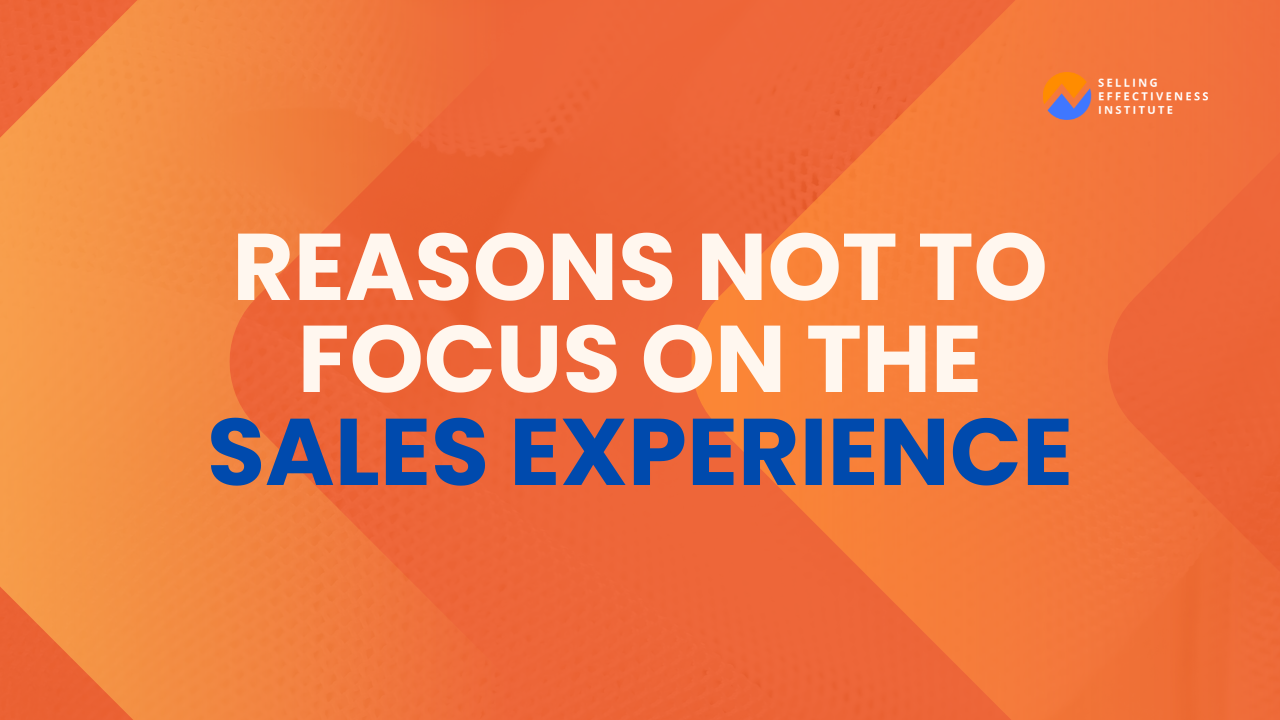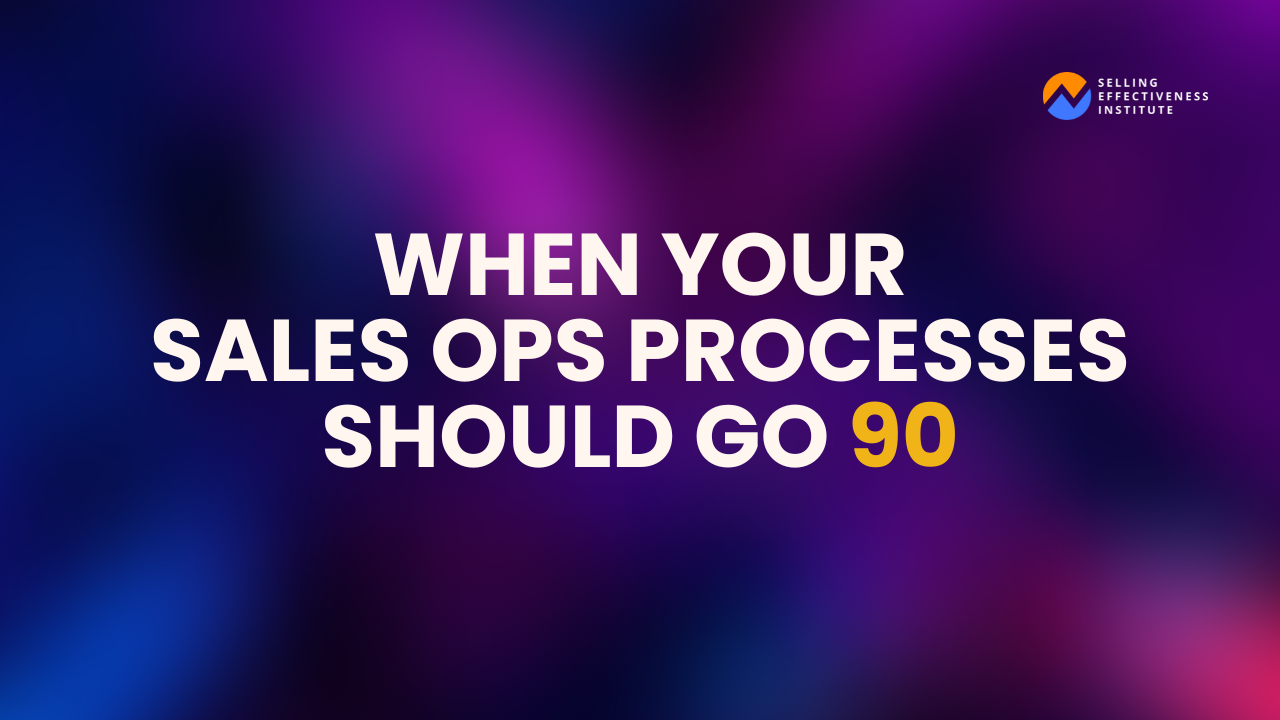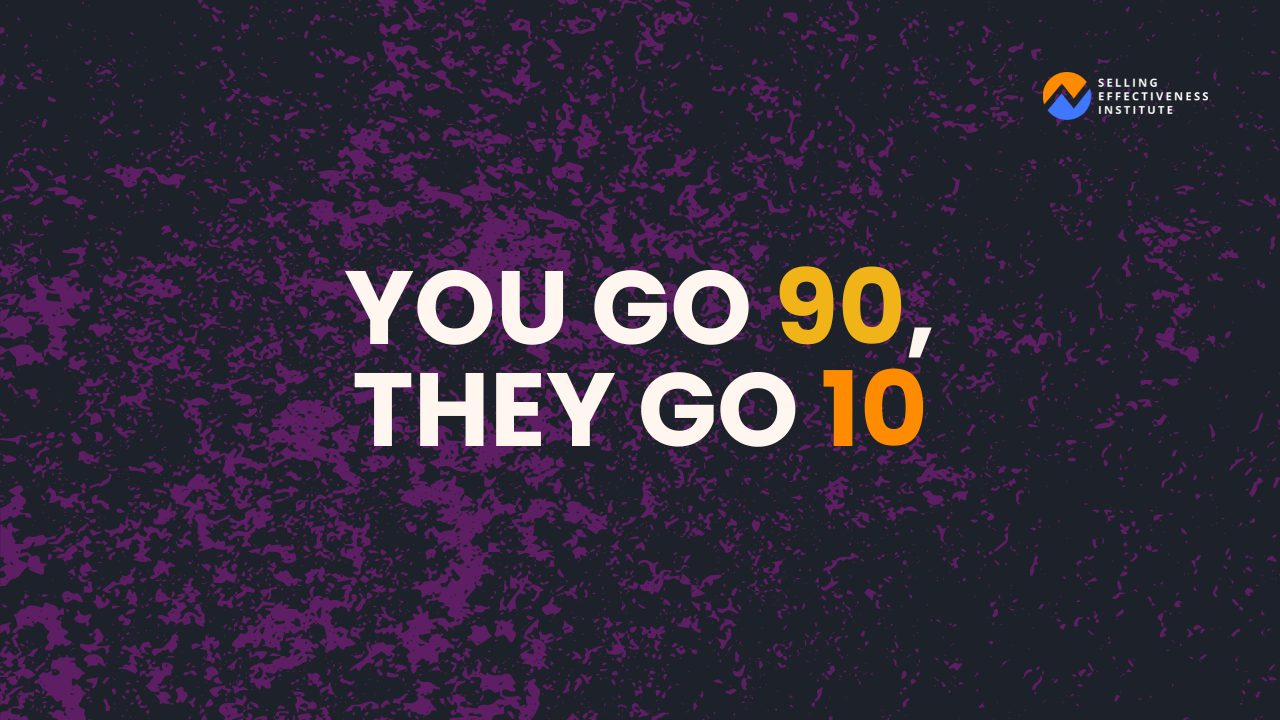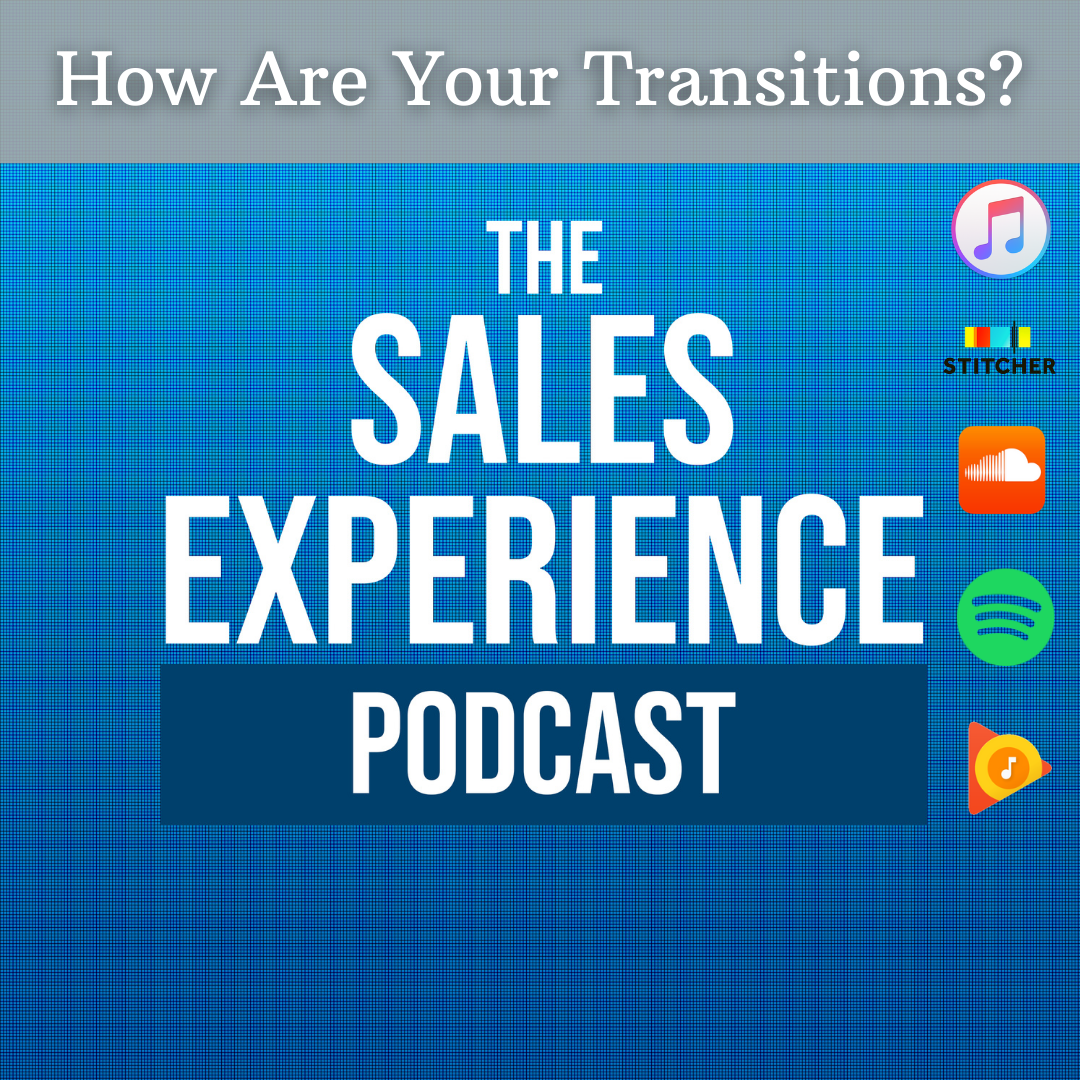Do you have solid transitions for moving through your sales conversation?
[E295] How Are Your Transitions?
Do you have solid transitions for moving through your sales conversation?
The transition is the bit that allows for a fluid movement from one portion of your sales process to the next.
Top performing salespeople are pros at the transition.
As you guessed it, struggling salespeople don’t usually have good transitions ready.
In this episode, I will cover why that happens, and how to build transitions that will help you close more deals.
Book your free Sales Power Call with Jason
Enroll in the Persuading Like A Professional Online Mini-Course
Download The Power of Authentic Persuasion ebook
-
Show Transcript
What's going on, everybody? Welcome to episode 295 of the Sales Experience Podcast. So glad that you're here. So let's dive into it. Earlier this week, I was having a conversation with my new friend, Ty Evans. He is an amazing sales leader. He's been in the insurance game for a long time. Wealth of knowledge.
And we just had a fun conversation. One thing that came up always comes up, especially among when you get two sales leaders together is talking about struggling salespeople and the order takers and how to get them to become quota breakers, sales professionals. And so when Ty and I were talking, he asked me, Hey, what are struggling salespeople missing versus what top.
Reps do really well in their sales conversations. And if I had to narrow it down to one of the biggest, most powerful and also most subtle things that top reps do really well, it's the transitions. So a transition is when you go from one thing to the next in TV and film, a transition is where you go from one scene to the next.
Some shows make a really big deal out of it and have some kind of transition effects or image that pops up. The one that came to mind when I was thinking about this is the movie Austin Powers where pretty much between every major scene there's a flashy 60s esque kind of music, dance, flash transition where you know it's going from one scene on to the next one and that marks that transition.
Some shows and films Can be hard to watch sometimes when they don't have much of a transition. And it's just jumping back and forth and you have to keep track. Is this a new scene and you have to pay attention. And so that can be difficult, sometimes jarring at times in sales. The transitions are super critical.
They mark when the conversation is going from one segment to the next. One issue that salespeople have is that they don't use transitions. They hope that the conversation is naturally just going to go from rapport to empathy and discovery to product presentation to the ask or an agreement on the deal where the customers hopefully.
Just wanting to do it and ask them how to buy, but the salesperson isn't necessarily intentional with it. They're not strategic with it and they don't have it planned. And usually they're not the ones driving the progression of that conversation and they're not in control. A professional salesperson will do two things.
They will be in control of the transitions and then also have them scripted out and ready at all times. They know how they're going to move from one part of the conversation to the next. Most reps are afraid of controlling anything. And typically it's because they don't like to be controlled, right? A lot of people sell the way they like to buy or they like to be in relationships and they don't want to be controlled.
They don't want to feel manipulated. They don't want to feel pushed towards anything a lot of times total sidebar But people usually have some control issues Maybe even growing up one parent was really controlling or a controlling relationship And so when they get into a sales role, they want anything but to be controlling to others Because they don't like how it feels to them, which I completely agree.
And it's really about how you do it and why you do it. The other part is that most reps are just not trained or provided the scripting on those transitions and how to do those effectively. So you want to make sure that you have a transition from every. Part of your process to the next, for me, what I train salespeople around is my refu framework, which again, if you've heard me talk, I have yet to find a good way to have it spell something cooler or snazzier.
And so it just works. You can't mess with the words, right? So the five sections are rapport, empathy. Trust, hope, and urgency. And so those have to happen in every sales process. Now, some of them are going to be longer. Some are going to be shorter. If there's a demo or a presentation, that's going to be in the trust hope phase, where it's about showing the prospective customer what it is that you provide and how it's going to apply to them.
And so with that means you have at least five transitions. So you have to go from rapport to empathy, to trust, trust, to hope, to urgency. urgency to a done deal. And so you've got to do all of those things and you've got to have those transitions laid out and ready to go. Let me give you an example of what it might sound like.
So imagine you're spending some time building rapport. Things are going well, and now you're ready to go on to the next phase, which would be the discovery phase. And for me, I put that under empathy, because when we're using empathy as the main vehicle, because I care about you, then I'm going to ask you questions, and I'm going to dig deep, and I'm going to use my curiosity, mixed with that empathy, in the discovery phase.
Moment of asking questions and wanting to know about you, right? So that's how I am going to use my empathy because I care about you and your situation. If I didn't care and it wasn't under the umbrella of empathy, I wouldn't ask any questions. And I see salespeople that do that all the time where they just don't ask questions because they just don't care and they think they know everything and they think they know exactly why this person would want to buy, whether it's a good fit or not, or whether they care or not.
The salesperson just knows like everybody wants this and everybody who's with your job title will always want this. So you should want it. And I don't really need to ask you questions because I don't really care. So let's say that you do care. You've finished your rapport section. Things are going well.
Now it's time for your discovery, for your empathy, for that part. And so you could say something like, Hey, that's really interesting. It's great to find that out about you. So what I'd like to do now is ask you some questions to give you an idea of what you're looking for. And then go into that question.
And the key is to not pause. The key is not having that break in the conversation. And what it sounds like when it's not done professionally is it could be like doing the rapport part. You finish it and then you say, Hey, that's really interesting. That's great to find out about how much you love asparagus.
I don't know what it is. And then a pause. And then a break. And then there's like this weird, dull silence where nobody knows what's going on. The salesperson's not in control and they don't know how to transition. The prospect is just waiting. They're hoping to be working with and talking with a professional.
And so they want the guidance and moving forward. And so far it's been a nice chat, but it's like, what's the point? Like, when are we going to get to the meat of this conversation? So you want to make sure you have that. And again, let me go through this transition example, just an example, but you say something, Hey, that's interesting.
Great to find that out about you. I love. that you're into that. Now, what I'd like to do is ask you some questions and give you an idea. Get an idea of what you're looking for and, see if this is something that could be a good fit for you. And so then all of a sudden it goes into it. And then the key is to say that statement and then keep going.
It's a transition. It's not a statement. It's not a declaration. It's a transition. So you're going from rapport. So your questions, this is the bridge and it's going to get you there and you just don't stop. Hey, that's really interesting. So the next part is that I want to ask you some questions so I can get an idea of what it is that you're looking for.
Tell me about your situation with X, right? Tell me about what you're doing now currently with Y. And then you just roll into it. It's a transition. It's not a statement. It's not a declaration. It's not a break. It's a transition. So remember that. And then when you get done with your empathy stage, right?
You've asked questions, you've discovered everything. Then you would use a transition to get to the trust phase and you would say something like all right So based on all the information you gave me which I really appreciate that's super helpful for me Let me tell you a bit about what we do and why it may be a good fit for you And why I think it could really help you and then roll into your part And so you want to have this transition where it goes from one Through to the next and what you're also doing in the transition that's super important is you're setting the expectation you're saying, Hey, we've finished this part.
We're going to go here next and here's what we're going to do and then here's why we're going to do it right. You don't just say, Hey, that's interesting that you really love asparagus. Tell me about your issues as a marketing manager. That's harsh and abrasive. And a lot of times what will happen is unless the person is really eager to talk to you and share, they're going to feel like, Oh my gosh, this just became a sale.
This is real. Now I got to put my defenses back up. I almost fell for this trap where he got me talking about asparagus. Then you have this tough battle. Sometimes people even say, Hey, wait a second. Why do you want to know that? Or. I don't really want to tell that to you. You tell me why. Tell me about your company.
And so instantly they're putting you on the spot. And so the transition is important because it's setting that expectation. Hey, we did this. Now we're going to go here and here's what we're going to do. And here's why we're going to do it. If you can put that in your transition statements, that's super important because if you can tell them, Hey, I want to ask you a bunch of questions because it's really important for me.
To see if this would be a good fit for you because it's not a good fit for everybody. And the last thing I want to do is waste your time. So what I'm going to do is ask you some questions and just get to know your situation. So tell me about your challenges as a marketing manager. And so then all of a sudden what you've done is you've set the expectation.
They know, Hey, this next part's questions. Here's why. See if it's a good fit. No pressure. That's great, right? You get done with your discovery questions. Then you're moving forward to your presentation, your monologue, your explanation, your demo, whatever that might be. Thank you for all that information.
That's super helpful. Based on what you told me, it sounds like we might be able to help you. And so now let me explain more about what we do and our process, our program, our product. Let me tell you a little bit more about myself. And then you go into that, right? And so then they know, okay, what's coming next is this, here's what I can expect.
When you do that, it works really well. And that's what truly separates the smooth effective sales professionals from the ones who struggle with closing deals because they generally struggle with that transition. They get done with their discovery questions and they just don't know what to do. And maybe you've had that experience where it's in a sales process or it's in a conversation or you're trying to ask somebody out on a date, which is very similar to this process.
And you're having a great conversation. You're talking and it's Okay, now what? What do I do? How do I get to the next phase of this interaction? And that's usually where people struggle and fail is that transition. So hopefully this helps. Hopefully this will help you build some amazing transitions.
If you want any help with this, you can send me an email jason at cutterconsultinggroup. com. You can find my information jasoncutter. com if you want to just go through there. If that's easier to remember and then that way you can get to me, you can also go on LinkedIn. So I'm very active on LinkedIn. You can send me a chat if you just have questions and want help with your transitions.
Just send me a chat, send me an email and be like, Hey, here's what I'm selling. Here's where I'm struggling with. I'm struggling from going from this point to this point. My conversations, what would you recommend? I'll give you some verbiage to try and then you can massage it from there. I love putting that stuff together and helping people with their scripting, with their transitions, with their process.
Because once you have those transitions down, I'm telling you, it takes so much pressure off because then you're just moving from one to the next. And then it's so much easier to close because now you've got the momentum and you've got a plan and a process. So hopefully that helps and hope everyone has a great weekend.
If you're listening to this on the day, it came out on Friday, the 25th of September and hopefully you're staying safe, staying sane. And I will catch you in the next episode of the sales experience podcast. That's it for another episode of the sales experience podcast. Thank you so much for listening. If you find yourself on iTunes, can you leave the show a rating and a review?
It helps other sales people and sales leaders find the show and please subscribe to the show and share episodes you find valuable with anyone you know in sales. Help me on my mission of changing the way. Sales is done. And if you're ready to work together, go to Jason cutter. com. Again, that's Jason cutter.
com to find out how I can help you or your company creates scalable sales success. I will see you on the next sales experience podcast episode, and keep in mind that everything in life is sales and people will remember the experience you gave them.
Become a Certified Authentic Persuader
Get the ebooks to help you close more deals
Visit
Selling Effectiveness for more tips and get help
Follow Jason on LinkedIn
Or go to Jason’s HUB – www.JasonCutter.com






Phone: (239) 206-1919 | Email: info@sellingeffectiveness.com
Copyright © 2023 Selling Effectiveness Institute. All rights reserved.







